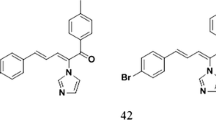Abstract
The in vitro activity of several new imidazoles, cloconazole, sulconazole, butoconazole, isoconazole and fenticonazole, were compared with those of amphothericin B, flucytosine, and three azoles: econazole, miconazole and ketoconazole against isolates of pathogenic Candida. A total of 186 clinical isolates of 10 species of the genus Candida and two culture collection strains were tested by an agar-dilution technique. Isoconazole was the most active azole, followed by butoconazole and sulconazole. Differences between some of the species in their susceptibility to the antifungal agents were noted. Sulconazole and cloconazole had the highest activity in vitro against 106 isolates of C. albicans. Butoconazole and isoconazole were also very active against isolates of C. albicans, and were the most active azole compounds against 80 isolates of Candida spp.
Similar content being viewed by others
References
Marrie TJ, Cooper JH, Costerton JW. Ultrastructure of Candida parapsilosis endocarditis. Infect Immun 1984; 45: 390–398.
Morgan MA, Wilkowske CJ, Roberts GD. Candida pseudotropicalis fungemia and invasive disease in an immunocompromised patient. J Clin Microbiol 1984; 20: 1006–1007.
Odds FC, Palacio A, Cuadra J, Sanchez J. Disseminated Candida infection syndrome in heroin addicts. J Med Microbiol 1987; 23: 275–277.
Reinhardt JF, Ruane PJ, Walker LJ, George WL. Intra- venous catheter-associated fungemia due to Candida rugosa. J Clin Microbiol 1985; 22: 1056–1057.
Graybill JR. Antifungal agents of the 1980's. Antimicrob News 1988; 5: 45–51.
McGinnis MR, Rinaldi MG. Antifungal drugs: mechanisms of action drug resistance, susceptibility testing, and assays of activity in biological fluids. In: Lorian VMD, ed. Antibiotics in laboratory medicine, 2nd ed. Baltimore: Williams & Wilkins, 1986: 223–281.
Dick JD, Rosengard BR, Merz WG, Stuart RK, Hutchins GM, Saral R. Fatal disseminated candidiasis due to am- phothericin B-resistant Candida guilliermondii. Ann Intern Med 1985; 102: 67–68.
Guinet R, Chanas J, Goullier A, Bonnefoy G, Ambroise-Thomas P. Fatal septicemia due to amphothericin B- resistant Candida lusitaniae. J Clin Microbiol 1983; 18: 443–444.
Douglas JB, Healy JK. 1969. Nephrotoxic effects of amphothericin B including renal tubular acidosis. Am J Med 1969; 46: 154–162.
Kauffman CA, Frame PT. Bone marrow toxicity associated with 5-fluorocytosine therapy. Antimicrob Agents Chemother 1977; 11: 244–247.
Gordon MA, Lapa EW, Passero PG. Improved method for azole antifungal susceptibility testing. J Clin Microbiol 1988; 26: 1874–1877.
Humphrey MJ, Jevons S, Tarbit MH. Pharmacokinetic of UK-49, 858, a metabolically stable triazole antifungal drug, in animals and humans. Antimicrob Agents Chemother 1985; 28: 648–653.
Lefler E, Stevens DA. New azole compounds: vibunazole (Bay n7133) and Bay 19139, compared with ketoconazole in the therapy of systemic candidosis and in pharmacokinetic studies, in mice. J Antimicrob Chemother 1985; 29: 660–662.
Rogers TE, Galgiani JN. Activity of fluconazole and ketoconazole against Candida albicans in vitro and in vivo. Antimicrob Agents Chemother 1986; 30: 418–422.
Cooper BH, Silva-Hutner M. Yeasts of Medical importance. In: Lennette EH, Balows A, Hausler WJ, Shadomy JH, eds. Manual of clinical microbiology, 4th ed. Wash- ington: American Society for Microbiology, 1985: 526–541.
Kreger van Rij NLW. The yeasts, a taxonomic study. New York: Elsevier, 1984.
Arx JA von, Schipper MAA. The CBS fungus collection. In: Perlman D, ed. Advances in applied microbiology. London: Academic Press, 1978: 215–236.
Shadomy S, Espinel-Ingroff A, Cartwright R. Laboratory studies with antifungical agents: susceptibility test and bioassays. In: Lennette EH, Balows A, Hausler WJ, Shadomy HJ, eds. Manual of clinical microbiology, 4th ed. Washington: American Society for Microbiology, 1985: 991–999.
Dick JD, Merz WG, Saral R. Incidence of polyene-resistant yeasts recovered from clinical specimens. Antimicrob Agents Chemother 1980; 18: 158–163.
Working group of the British Society for Mycopathology. Laboratory methods for flucytosine (5-fluorocytosine). J Antimicrob Chemother 1984; 14: 1–8.
Guinet R, Nerson D, De Closets F, Dupouy-Camet J, Kures L, Marjollet M, Poirot JL, Ros A, Texier-Maugein J, Volle PJ. Collaborative evaluation in seven laboratories of a standardized micromethod for yeast susceptibility testing. J Clin Microbiol 1988; 26: 2307–2312.
Iwata K. Drug resistance in human pathogenic fungi. In: Iwata K, Den Bossche H van, eds. In vitro and in vivo evaluation of antifungal agents. Amsterdam: Elsevier, 1986: 65–86.
Johnson EM, Richard MD, Warnock DN. In vitro resistance to imidazole antifungals in Candida albicans. J Antimicrob Chemother 1984; 13: 547–558.
Riley JF, Wilson RG, Barrett-Bee J. Azole resistance in Candida albicans. Sabouraudia 1984; 22: 53–63.
Whelan WL, Kerridge D. Decreased activity of UMP pyrophosphorylase associated with resistance to 5-fluorocytosine in Candida albicans. Antimicrob Agents Chemother 1984; 26: 570–574.
Hamilton-Miller JM. A comparative in vitro study of amphotericin B, clotrimazole and 5-fluorocytosine against clinically isolated yeasts. Sabouraudia 1972; 10: 276–283.
Espinel-Ingroff A, Shadomy S, Gebhart RJ. In vitro studies with R 51,211. Antimicrob Agents Chemother 1984; 26: 5–9.
Hussain Qadri SMH, Flournoy DJ, Qadri SGM, Ramirez EG. Susceptibility of clinical isolates of yeasts to antifun- gal agents. Mycopathologia 1986; 95: 183–187.
Author information
Authors and Affiliations
Rights and permissions
About this article
Cite this article
Molina, J.M.H., Losá, J., Brocal, A.M. et al. In vitro activity of cloconazole, sulconazole, butoconazole, isoconazole, fenticonazole, and five other antifungal agents against clinical isolates of Candida albicans and Candida spp.. Mycopathologia 118, 15–21 (1992). https://doi.org/10.1007/BF00472565
Received:
Accepted:
Issue Date:
DOI: https://doi.org/10.1007/BF00472565




